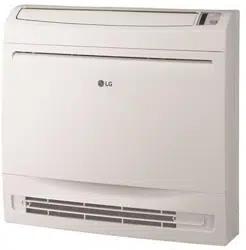Loading ...
Loading ...
Loading ...

Rooftop Installations
If the outdoor unit is installed on a roof structure, be sure to level the unit. Ensure the roof structure and anchoring method are adequate for
the unit location. Consult local codes regarding rooftop mounting.
PLACEMENT CONSIDERATIONS
Selecting the Best Location for the Outdoor Unit, continued.
• Where it will not be subjected to direct thermal radiation from other heat sources, nor an area that would not expose the outdoor unit to
heat or steam like discharge from boiler stacks, chimneys, steam relief ports, other air conditioning units, kitchen vents, plumbing vents,
and other sources of extreme temperatures.
• Where high-frequency electrical noise / electromagnetic waves will not affect operation.
• Where operating sound from the unit will not disturb inhabitants of surrounding buildings.
• Where the unit will not be exposed to direct, strong winds.
Ocean winds
Ocean winds
Ocean winds
Windbreaker
Planning for Snow and Ice
In climates that experience snow buildup, place the unit on a raised platform to ensure proper condenser airflow. The raised support platform
must be high enough to allow the unit to remain above possible snow drifts. Mount the unit on a field-provided stand that is higher than the
maximum anticipated snowfall for the location. Design the mounting base to prevent snow accumulation on the platform in front or back of
the unit case. If necessary, provide a field fabricated hood to keep snow and ice and/or drifting snow from accumulating on the coil surfaces.
Use inlet and discharge duct or hoods to prevent snow or rain from accumulating on the fan inlet and outlet guards. Best practice prevents
snow from accumulating on top of the unit. Consider tie-down requirements in case of high winds or where required by local codes.
Oceanside Installation Precautions
• Install the outdoor unit on the side of the
building opposite from direct ocean winds.
• Select a location with good drainage.
• Periodically clean dust or salt particles off of
the heat exchanger with water.
•
Avoid installing the outdoor unit where it
would be directly exposed to ocean winds.
Additional anti-corrosion treatment will need
to be applied to the outdoor unit at oceanside
locations.
If the outdoor unit must be placed in a
location where it would be subjected to
direct ocean winds, install a concrete
windbreaker strong enough to block any
winds. Windbreaker height and width
must be more than 150% of the outdoor
unit, and be installed at least 27-1/2
inches away from the outdoor unit to
allow for airflow.
Ocean winds will cause corrosion, particularly on the condenser and evaporator ns, which,
in turn could cause product malfunction or inefcient performance.
• Where piping between the outdoor unit, indoor unit(s), and BD units (Multi F MAX systems only) are within allowable limits.
• Include space for drainage to ensure condensate flows properly out of the unit when it is in heating mode. Avoid placing the outdoor unit
in a low-lying area where water could accumulate.
Due to our policy of continuous product innovation, some specications may change without notication.
©LG Electronics U.S.A., Inc., Englewood Cliffs, NJ. All rights reserved. “LG” is a registered trademark of LG Corp.
214 | APPLICATION GUIDELINES
Multi F and Multi F MAX Indoor Unit Engineering Manual
MULTI
F
MAX
MULTI
F
Loading ...
Loading ...
Loading ...
